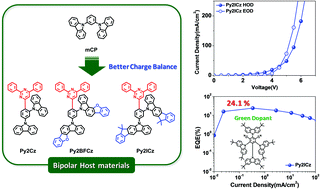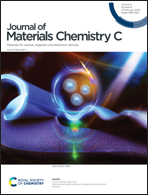Pyrimidine-based bipolar host materials for high efficiency solution processed green thermally activated delayed fluorescence OLEDs†
Abstract
The development of bipolar host materials for solution-processable thermally activated delayed fluorescence organic light-emitting diodes (TADF-OLEDs) is challenging because few host materials for TADF-OLEDs have been reported. Solution-processable bipolar host materials should have good solubility in various organic solvents and should exhibit good thermal stability and film-forming properties. In this study, three bipolar host materials (i.e.Py2Cz, Py2BFCz, and Py2ICz) for solution-processable green-emitting TADF-OLEDs were synthesized by coupling 2,4-diphenylpyrimidine to mCP and modifying the carbazole-donating units in the mCP structure. Thus, the effects of different host structures on the performance of green TADF-OLEDs could be investigated. The three host materials exhibited high thermal stability and fine morphologies in film states. Therefore, all three host materials were utilized to fabricate solution-processed green TADF-OLEDs with a green-emitting dopant. Particularly, the Py2ICz-based device displayed outstanding performance with a maximum external efficiency of 24.1% because Py2ICz has superior charge balance in the emitting layer than the others. These results unambiguously demonstrated that mCP derivatives with a pyrimidine core are suitable bipolar host materials for solution-processed green TADF-OLEDs.

- This article is part of the themed collection: Journal of Materials Chemistry C Lunar New Year collection 2021


 Please wait while we load your content...
Please wait while we load your content...